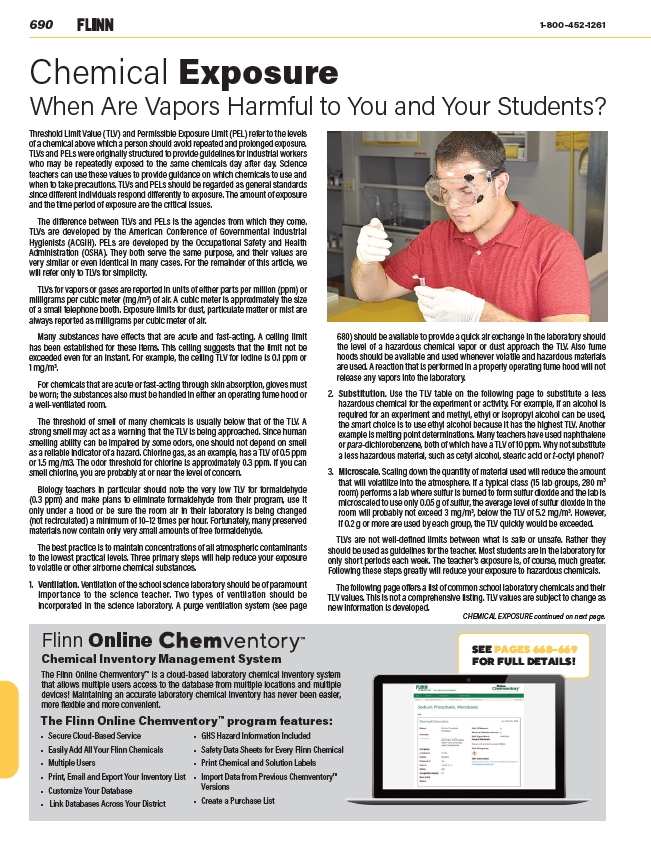
690 1-800-452-1261
Chemical Exposure
When Are Vapors Harmful to You and Your Students?
Threshold Limit Value (TLV) and Permissible Exposure Limit (PEL) refer to the levels
of a chemical above which a person should avoid repeated and prolonged exposure.
TLVs and PELs were originally structured to provide guidelines for industrial workers
who may be repeatedly exposed to the same chemicals day after day. Science
teachers can use these values to provide guidance on which chemicals to use and
when to take precautions. TLVs and PELs should be regarded as general standards
since different individuals respond differently to exposure. The amount of exposure
and the time period of exposure are the critical issues.
The difference between TLVs and PELs is the agencies from which they come.
TLVs are developed by the American Conference of Governmental Industrial
Hygienists (ACGIH). PELs are developed by the Occupational Safety and Health
Administration (OSHA). They both serve the same purpose, and their values are
very similar or even identical in many cases. For the remainder of this article, we
will refer only to TLVs for simplicity.
TLVs for vapors or gases are reported in units of either parts per million (ppm) or
milligrams per cubic meter (mg/m3) of air. A cubic meter is approximately the size
of a small telephone booth. Exposure limits for dust, particulate matter or mist are
always reported as milligrams per cubic meter of air.
Many substances have effects that are acute and fast-acting. A ceiling limit
has been established for these items. This ceiling suggests that the limit not be
exceeded even for an instant. For example, the ceiling TLV for iodine is 0.1 ppm or
1 mg/m3.
For chemicals that are acute or fast-acting through skin absorption, gloves must
be worn; the substances also must be handled in either an operating fume hood or
a well-ventilated room.
The threshold of smell of many chemicals is usually below that of the TLV. A
strong smell may act as a warning that the TLV is being approached. Since human
smelling ability can be impaired by some odors, one should not depend on smell
as a reliable indicator of a hazard. Chlorine gas, as an example, has a TLV of 0.5 ppm
or 1.5 mg/m3. The odor threshold for chlorine is approximately 0.3 ppm. If you can
smell chlorine, you are probably at or near the level of concern.
Biology teachers in particular should note the very low TLV for formaldehyde
(0.3 ppm) and make plans to eliminate formaldehyde from their program, use it
only under a hood or be sure the room air in their laboratory is being changed
(not recirculated) a minimum of 10–12 times per hour. Fortunately, many preserved
materials now contain only very small amounts of free formaldehyde.
The best practice is to maintain concentrations of all atmospheric con taminants
to the lowest practical levels. Three primary steps will help reduce your exposure
to volatile or other airborne chemical substances.
1. Ventilation. Ventilation of the school science laboratory should be of paramount
importance to the science teacher. Two types of ventilation should be
incorporated in the science laboratory. A purge ventilation system (see page
680) should be available to provide a quick air exchange in the laboratory should
the level of a hazardous chemical vapor or dust approach the TLV. Also fume
hoods should be available and used whenever volatile and hazardous materials
are used. A reaction that is performed in a properly operating fume hood will not
release any vapors into the laboratory.
2. Substitution. Use the TLV table on the following page to substitute a less
hazardous chemical for the experiment or activity. For example, if an alcohol is
required for an experiment and methyl, ethyl or isopropyl alcohol can be used,
the smart choice is to use ethyl alcohol because it has the highest TLV. Another
example is melting point determinations. Many teachers have used naphthalene
or para-dichlorobenzene, both of which have a TLV of 10 ppm. Why not substitute
a less hazardous material, such as cetyl alcohol, stearic acid or t-octyl phenol?
3. Microscale. Scaling down the quantity of material used will reduce the amount
that will volatilize into the atmosphere. If a typical class (15 lab groups, 280 m3
room) performs a lab where sulfur is burned to form sulfur dioxide and the lab is
microscaled to use only 0.05 g of sulfur, the average level of sulfur dioxide in the
room will probably not exceed 3 mg/m3, below the TLV of 5.2 mg/m3. However,
if 0.2 g or more are used by each group, the TLV quickly would be exceeded.
TLVs are not well-defined limits between what is safe or unsafe. Rather they
should be used as guidelines for the teacher. Most students are in the laboratory for
only short periods each week. The teacher’s exposure is, of course, much greater.
Following these steps greatly will reduce your exposure to hazardous chemicals.
The following page offers a list of common school labora tory chemicals and their
TLV values. This is not a com pre hen sive listing. TLV values are subject to change as
new information is developed.
Flinn Online
Chemical Inventory Management System
The Flinn Online Chemventory™ is a cloud-based laboratory chemical inventory system
that allows multiple users access to the database from multiple locations and multiple
devices! Maintaining an accurate laboratory chemical inventory has never been easier,
more flexible and more convenient.
CHEMICAL EXPOSURE continued on next page.
The Flinn Online Chemventory™ program features:
• Secure Cloud-Based Service
• Easily Add All Your Flinn Chemicals
• Multiple Users
• Print, Email and Export Your Inventory List
• Customize Your Database
• Link Databases Across Your District
• GHS Hazard Information Included
• Safety Data Sheets for Every Flinn Chemical
• Print Chemical and Solution Labels
• Import Data from Previous Chemventory™
Versions
• Create a Purchase List
SEE PAGES 668–669
FOR FULL DETAILS!